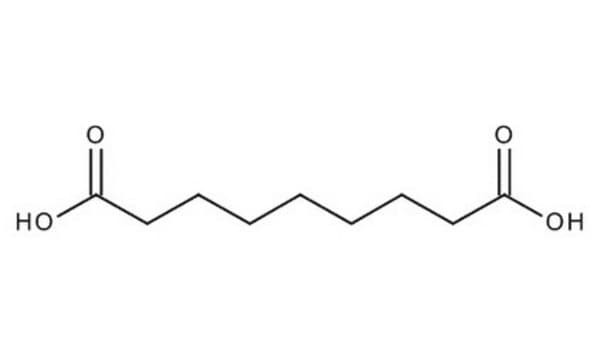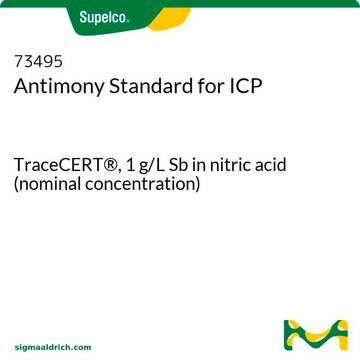11480
Azelaic acid
technical, ~85% (GC)
Sinónimos:
Nonanedioic acid
About This Item
Productos recomendados
densidad de vapor
6.5 (vs air)
Nivel de calidad
presión de vapor
<1 mmHg ( 20 °C)
grado
technical
Análisis
~85% (GC)
bp
286 °C/100 mmHg (lit.)
mp
109-111 °C (lit.)
cadena SMILES
OC(=O)CCCCCCCC(O)=O
InChI
1S/C9H16O4/c10-8(11)6-4-2-1-3-5-7-9(12)13/h1-7H2,(H,10,11)(H,12,13)
Clave InChI
BDJRBEYXGGNYIS-UHFFFAOYSA-N
¿Está buscando productos similares? Visita Guía de comparación de productos
Categorías relacionadas
Descripción general
Aplicación
- A phase 3 randomized, double-blind, vehicle-controlled trial of azelaic acid foam 15% in the treatment of papulopustular rosacea: This study evaluates the efficacy and safety of a 15% azelaic acid foam in treating rosacea, demonstrating significant improvements in disease severity (Draelos et al., 2015).
- Comparison of the characteristics of transfersomes and protransfersomes containing azelaic acid: This research compares the properties of transfersome formulations with azelaic acid, highlighting their potential for enhanced delivery in dermatological applications (Rahmi and Pangesti, 2018).
- Enhancing the bioconversion of azelaic acid to its derivatives by response surface methodology: This article discusses optimizing the production of azelaic acid derivatives, which are crucial for cosmetic and pharmaceutical applications (Khairudin et al., 2018).
- Azelaic acid: a bio-based building block for biodegradable polymers: The study explores azelaic acid as a sustainable precursor for producing biodegradable polymers, pertinent to material science (Todea et al., 2021).
- Preparation and evaluation of azelaic acid topical microemulsion formulation: in vitro and in vivo study: This research presents a microemulsion formulation of azelaic acid, assessing its stability and skin permeability, critical for topical therapeutic applications (Hung et al., 2021).
Acciones bioquímicas o fisiológicas
Palabra de señalización
Warning
Frases de peligro
Consejos de prudencia
Clasificaciones de peligro
Eye Irrit. 2 - Skin Irrit. 2
Código de clase de almacenamiento
11 - Combustible Solids
Clase de riesgo para el agua (WGK)
WGK 1
Punto de inflamabilidad (°F)
410.0 °F - closed cup
Punto de inflamabilidad (°C)
210 °C - closed cup
Equipo de protección personal
Eyeshields, Gloves, type N95 (US)
Choose from one of the most recent versions:
¿Ya tiene este producto?
Encuentre la documentación para los productos que ha comprado recientemente en la Biblioteca de documentos.
Los clientes también vieron
Nuestro equipo de científicos tiene experiencia en todas las áreas de investigación: Ciencias de la vida, Ciencia de los materiales, Síntesis química, Cromatografía, Analítica y muchas otras.
Póngase en contacto con el Servicio técnico









